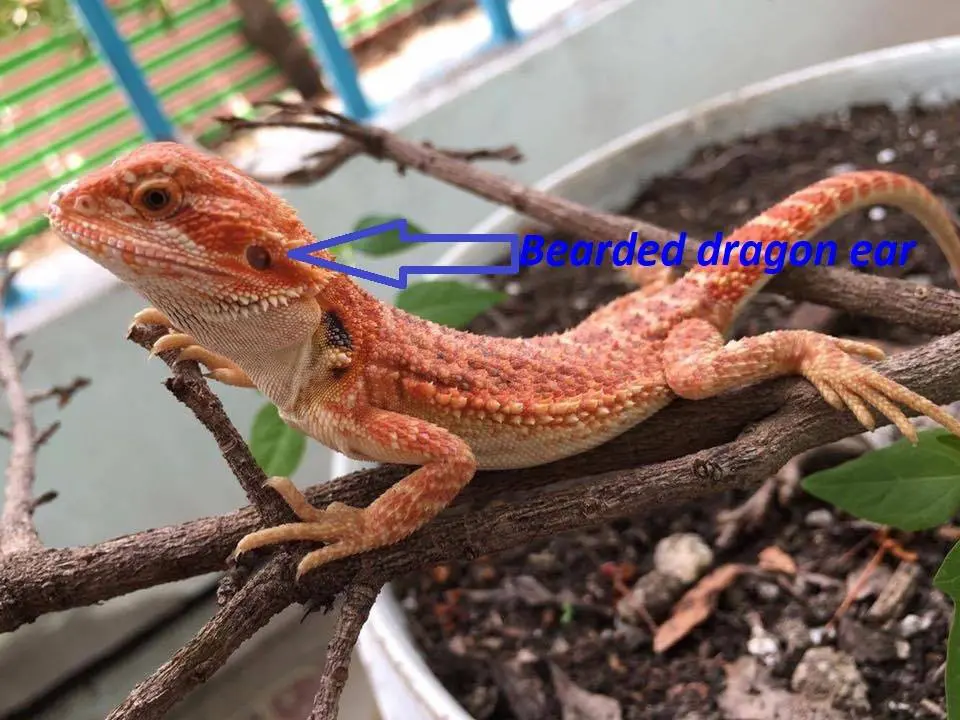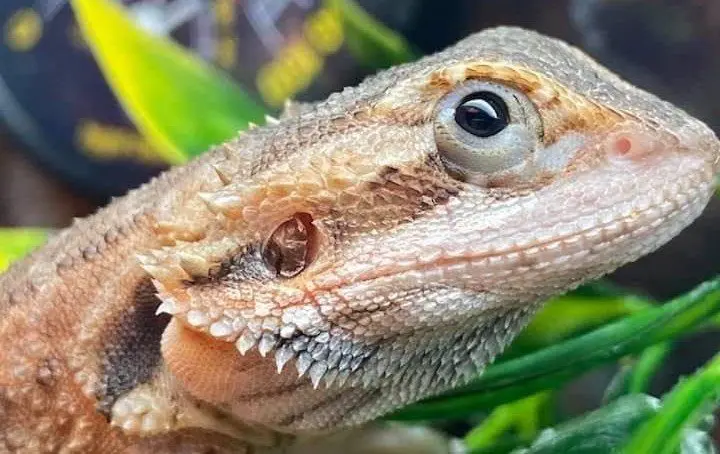Bearded dragons can also suffer from ear infections, the same as a human or other pet. The ear infection in these reptiles is often caused by fungal or bacterial infections with mild to severe symptoms, including neurological symptoms in the event of an inner ear infection.
Where Are A Bearded Dragon’s Ears?
Unlike humans and other pets, bearded dragons don’t have protruding ears, you may even be under the impression that they don’t have ears at all.
They do not have external ear structures to collect sound, but simple holes with no external lobes. Though a bearded dragon will have excellent hearing.

Where are the Ears?
The ears of a bearded dragon are holes which can be found on either side of the head, further back than the eyes. The ear can be found halfway down between the mouth and eye. They have a thin membrane which is recessed and crosses the hole opening.
How Does the Ears Work?
Looking at the inside of the bearded dragon’s ear, it is very similar to ours. They rely on membranes and bones to transmit sound to a cavity. The cavity is filled with liquid which changes vibrations and pressure.
Vibrations in the liquid stimulate sensory cells, transmitting an electrical impulse along an auditory nerve to interpret any sounds being heard.
Middle and Inner Ear
Bearded dragons also have an inner and middle ear, the same as mammals.
The tympanic membrane is responsible for covering the middle ear, responding to sound waves with a small bone that sits in the middle of the ear, running between the inner ear and the tympanic membrane, which transmits vibrations to the bone, through the inner ear.
The inner ear then contains the cochlear duct, filled with fluid. This is responsible for picking up vibrations and then sending them to the auditory nerve and to the brain.
The inner ear is what contains all the organs to regular balance. Even though the ear looks completely different from a human, it works the same way.
Bearded Dragon Ear Infection Symptoms
There are a number of symptoms that can indicate an ear infection in your bearded dragon. These include:
- Swollen tympanic membrane, film covering ear holes.
- Discharge from the ear
- Hearing loss
- Black or brown spots in the ear
- Head tilting
- Loss of balance
An inner ear infection will impact your dragon’s balance. It’s not uncommon for bearded dragons with an ear infection to tilt their heads to one side, losing their balance and being disorientated.
Ear Infection Causes
Ear infections are often a result of a fungal or bacterial infection, though your bearded dragon’s habitat and living conditions will play a role in its ability to fight off infection.
A lowered immune system can make it harder for your reptile pet to fight infection in the ear.
Temperature
In order to keep your bearded dragon strong and healthy with an excellent immune system, you have to ensure their habitat is set up for optimum levels.
Bearded dragons are used to a warm and dry habitat with basking areas, where they can soak up the UV rays in the sun, which helps to reduce the risk of metabolic bone disease.
These dragons require daytime temperatures of between 75ºF and 85ºF with basking temperatures ranging between 88ºF and 100ºF. Night temperatures can drop as low as 70ºF. Ensure you use a digital thermometer to monitor temperatures with ease.
Humidity
Bearded dragons have a low humidity requirement of between 20% to 40%. It’s not uncommon for humidity levels to get too high and for infections to surface.
Use a digital hygrometer which will be able to assist you in accurately monitoring the humidity levels in real-time and with ease.
Shedding

Did you know that bearded dragons actually shed their ears as well? Probably not, it’s not something you expect.
It’s not uncommon for your dragon to struggle when it comes to shedding, especially when you have incorrect humidity levels. It’s possible that shedding hasn’t been completed in the ear and can result in discomfort and possible infection.
Monitor your humidity levels during this period and provide your dragon with warm baths to soak and loosen old skin, helping it come away easier.
Diet
Diet plays a vital role in how healthy your dragon is. Remember in captivity, your dragon isn’t getting the varied diet they are used to in the wild. They are not getting natural sunshine to produce Vitamin D and Calcium.
A poor-quality diet that doesn’t offer a mix of vegetables, greens, and vegetables along with crickets and other insects can result in a lower immune system response when fighting off infection.
Bearded Dragon Ear Infection Treatment
The minute you feel there is concern regarding your dragon’s ears, you are going to want to make an appointment with the vet.
The vet will conduct a thorough analysis and diagnose your dragon. If diagnosed with an ear infection, you will need to give your dragon antibiotics. Antibiotics should only be administered as per your vet’s instruction.
Bearded Dragon Ear Infection Prevention
Temperatures
The first preventative tip you can make is to purchase a good quality digital thermometer which will enable you to measure the enclosure’s temperature in real-time for effective and ongoing monitoring.
Ensure your temperatures remain at optimum to keep your dragon healthy and strong.
Humidity
In order to keep your humidity levels at optimum, which is between twenty and forty percent, you will want to look at your current humidity. Chances are the humidity in the enclosure is a bit high, it’s common with glass enclosures.
You can lower humidity by eliminating any misting and removing the water bowl from your dragon’s enclosure to adding a mesh screen lid on the top, which will improve ventilation.
Diet
It’s imperative that you provide your bearded dragon with the diet it needs to remain strong and healthy and able to fight off infection.
This means a diet made up of leafy greens, vegetables, fruits, and insects. Insects should be gut loaded and dusted with a multivitamin and/or Calcium and Vitamin D3 vitamins for the best results.
UV Light
Provide your bearded dragon with the benefits of natural sunlight using a UV bulb. This can help them maintain a strong immune system, reducing the risk of ear infection.